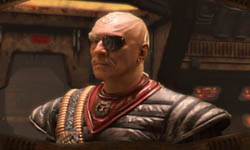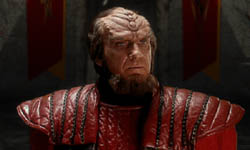|
|
 |
TREKCORE >
GAMING >
KLINGON ACADEMY > Behind The Scenes
A Good Day To Die: Klingons in the Recording Studio
Courtesy of FilmSound.org.
 "Every day is a good day to die if you're fighting your enemies," directs Interplay's Voice Talent supervisor Chris Borders. Unleashing the Klingon spirit in Hollywood's finest voice talent requires coaching in Klingon attitude. "Be happy to be angry!" is the battle cry in studios such as Screenmusic in Studio City where Borders recorded the actors for Interplay's epic new Star Trek game. "Klingons are like proud Roman soldiers with the anger of cave men," say Borders. Anything to inspire the hotheaded growl of a Klingon. Borders will even roll up his sleeves and demonstrate the head-butting demeanor of an Academy reared warrior. "You have to talk like this, " says Chris, lowering the pitch of his voice with a hint of barbaric shiftiness thrown in. Gene Roddenberry created the brutish Klingon race in the original Star Trek television series nearly 30 years ago. Although the make-up has changed, their signature barbarian, blood-lusting nature remains. Several months ago Borders was handed a hefty KA script calling for over 40 unique Klingon characters. But where do you find such a bewildering number of leather clad, knife brandishing intergalactic aliens? One of Chris' responsibilities at Interplay is establishing contacts with some of Hollywood's top talent agents. "I have a good relationship with many of these talent agencies, and they provide me with a tremendous amount of help to find the best actors for the job." Together with several agents, Borders began the tough task of auditioning about one hundred prospective Klingons. There were tall Klingons, short Klingons, big and thin Klingons but the deciding characteristic of a good Klingon, says Borders, is "a deep, tough voice." "Sometimes I have to take it over the top a little because in voice-over, the audience can't see the actors. We have to exaggerate the Klingon voice characteristics in lieu of the long straggly hair and spiny, ruffled foreheads. The surprise for me was that some of the biggest guys just didn't sound right. More anger! Put some gravel in your voice. Think of the Klingon pride!" prods Borders.
"Every day is a good day to die if you're fighting your enemies," directs Interplay's Voice Talent supervisor Chris Borders. Unleashing the Klingon spirit in Hollywood's finest voice talent requires coaching in Klingon attitude. "Be happy to be angry!" is the battle cry in studios such as Screenmusic in Studio City where Borders recorded the actors for Interplay's epic new Star Trek game. "Klingons are like proud Roman soldiers with the anger of cave men," say Borders. Anything to inspire the hotheaded growl of a Klingon. Borders will even roll up his sleeves and demonstrate the head-butting demeanor of an Academy reared warrior. "You have to talk like this, " says Chris, lowering the pitch of his voice with a hint of barbaric shiftiness thrown in. Gene Roddenberry created the brutish Klingon race in the original Star Trek television series nearly 30 years ago. Although the make-up has changed, their signature barbarian, blood-lusting nature remains. Several months ago Borders was handed a hefty KA script calling for over 40 unique Klingon characters. But where do you find such a bewildering number of leather clad, knife brandishing intergalactic aliens? One of Chris' responsibilities at Interplay is establishing contacts with some of Hollywood's top talent agents. "I have a good relationship with many of these talent agencies, and they provide me with a tremendous amount of help to find the best actors for the job." Together with several agents, Borders began the tough task of auditioning about one hundred prospective Klingons. There were tall Klingons, short Klingons, big and thin Klingons but the deciding characteristic of a good Klingon, says Borders, is "a deep, tough voice." "Sometimes I have to take it over the top a little because in voice-over, the audience can't see the actors. We have to exaggerate the Klingon voice characteristics in lieu of the long straggly hair and spiny, ruffled foreheads. The surprise for me was that some of the biggest guys just didn't sound right. More anger! Put some gravel in your voice. Think of the Klingon pride!" prods Borders.
 Then there was the challenge of finding a friendlier, more rational Klingon. The lead role in Klingon Academy is Torlek, a character we hear but never really see. Because you, the player, play the part of Torlek, the development team decided to create a Klingon that could remain likeable, a Klingon we can all empathize with. In the long history of Star Trek, one Klingon stands out as a gentleman: Warf from Star Trek Next Generation. Unfortunately, Klingon Academy takes place about two generations before Lieutenant Warf's time. Borders needed to find a Klingon with a similar temperament and after many auditions, he found Greg Eagles (Fallout 2). Greg uses Torlek's thoughtful moments to show the audience the sensitive side of these quarrelsome extraterrestrials. Later, Interplay was fortunate to beam in the real Warf, Michael Dorn (arguably the only household name on Earth for the Klingon race) to play a distant relative. Judging by the impressive credits on many of Interplay's games one might suspect that the company is searching for bankable talent, but Borders is not looking for name actors, he is looking for the right stuff for each role. Frequently, this leads Chris to some big names in Hollywood. Klingon Academy's credits include Chistopher Plummer (The Insider) revisiting his role as General Chang from Star Trek VI. Also back from The Undiscovered Country is David Warner (Titanic) as Chancellor Gorkon, and Star Trek original series luminary George Takei (Hikiro Sulu). Border's first day on the job with Interplay was sitting in on a recording session for Star Trek Judgment Rites with Takei. Now Takei reprises his role from Star Trek VI as Captain Sulu of the USS Excelsior in Klingon Academy.
Then there was the challenge of finding a friendlier, more rational Klingon. The lead role in Klingon Academy is Torlek, a character we hear but never really see. Because you, the player, play the part of Torlek, the development team decided to create a Klingon that could remain likeable, a Klingon we can all empathize with. In the long history of Star Trek, one Klingon stands out as a gentleman: Warf from Star Trek Next Generation. Unfortunately, Klingon Academy takes place about two generations before Lieutenant Warf's time. Borders needed to find a Klingon with a similar temperament and after many auditions, he found Greg Eagles (Fallout 2). Greg uses Torlek's thoughtful moments to show the audience the sensitive side of these quarrelsome extraterrestrials. Later, Interplay was fortunate to beam in the real Warf, Michael Dorn (arguably the only household name on Earth for the Klingon race) to play a distant relative. Judging by the impressive credits on many of Interplay's games one might suspect that the company is searching for bankable talent, but Borders is not looking for name actors, he is looking for the right stuff for each role. Frequently, this leads Chris to some big names in Hollywood. Klingon Academy's credits include Chistopher Plummer (The Insider) revisiting his role as General Chang from Star Trek VI. Also back from The Undiscovered Country is David Warner (Titanic) as Chancellor Gorkon, and Star Trek original series luminary George Takei (Hikiro Sulu). Border's first day on the job with Interplay was sitting in on a recording session for Star Trek Judgment Rites with Takei. Now Takei reprises his role from Star Trek VI as Captain Sulu of the USS Excelsior in Klingon Academy.
Recording voice over for Klingon Academy was a big job, but some of most challenging moments were during the filming of KA's many full motion video segments. For two days, torrential El Nino rains battered down on the sound stage roof and interrupted recording. An additional headache for Borders was that Klingon Academy was filmed using state-of-the-art graphics equipment that included three tables of CG computers, digital beta-cam recorders, and an array of infrared projectors. All of this machinery created so much noise on the set that Borders was forced to improvise some sound baffling. He clipped over 30 wool blankets around the workstations, making it possible to record General Chang's rousing speeches. Despite the pouring rain and demanding hi-tech filming environment, the performances in KA bristle with Klingon ferocity. Borders recalls that during the filming of a critical scene Plummer and Warner outdid themselves. "Plummer and Warner know each other from their days as Shakespearian actors. A few minutes after they greeted each other with a hug, they were into a rehearsal of an intense argument, totally engaged with each other in a furious debate."

Christopher Plummer as General Chang |

David Warner as Chancellor Gorkon |
After the drama of Hollywood's recording studios and film sets, the daunting amount of Klingon voice recordings goes into editing at Interplay. Thousands of character lines are selected and cut into files. The edited dialog is then passed on to mastering where all of Klingon Academy's sound is balanced and implemented into the interactive game environment. Only hours of playtesting can provide the feedback needed to find potential problems with voice playback. In some cases, Borders returns to the studio for pick-up sessions to fine tune specific lines. In the finished product, dialog serves as feedback for critical gameplay situations, entertains in KA's video sequences, and immerses the player in alien Klingon mannerisms. Klingon Academy will give gamers an opportunity to hear Klingon slang, Klingon speeches, Klingon gibes, and Klingons on the bridge of a massive battlecruiser. Q'apla!
|





